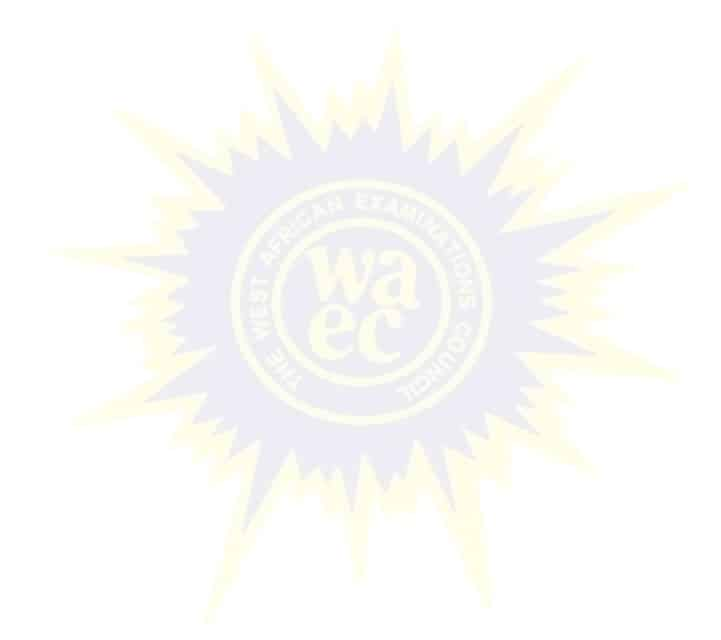
Economics
Paper 1 | Objectives | 47 Questions
WASSCE/WAEC MAY/JUNE
Year: 2008
Level: SHS
Time:
Type: Question Paper
Answers provided
FREE
No description provided
Feedbacks
This paper is yet to be rated

Paper 1 | Objectives | 47 Questions
WASSCE/WAEC MAY/JUNE
Year: 2008
Level: SHS
Time:
Type: Question Paper
Answers provided
No description provided
This paper is yet to be rated
Eat well during in test days for good grades. How can you plan your exam diet with good grades in mind?
Tips to make the best study space and quality time for studies are essential.
These are the three things to do in test preparation for higher grades and excellent performance.
| # | Question | Ans |
|---|---|---|
| 1. |
The main concern of economists is to A. allocate scarce resouces to satisfy human wants B. satisfy all human wants C. redistribute income between the rich and the poor D. control the growth of population
Show Content
Detailed SolutionThe main objectives of economics are to allocate scarce resources to satisfy human wants. |
|
| 2. |
Productive resources can also be called A. principle of production B. factors of production C. items of production D. labour and material resources
Show Content
Detailed SolutionProductive resources are otherwise known as factors of production. These are the resources used to produce goods and services. They include; land, labour, capital and entrepreneur. |
|
| 3. |
Production covers all the following except when A. utility is created B. a good is manufactured C. a commodity is consumed D. individual wants are satisfied
Show Content
Detailed SolutionProduction is the organized activity of transforming resources into finished products in the form of goods and services; the objective of production is to satisfy the needs of the final consumer.This production involves the identification of human needs, producing goods that have utility to satisfy humans. It doesn't involve when goods are consumed. |
|
| 4. |
Data presented in tables are usually arranged in A. charts and graphs B. rows and columns C. graph and rows D. columns and charts
Show Content
Detailed SolutionData presented in tables are usually arranged in rows and columns. Rows runs horizontally while Columns runs vertically. |
|
| 5. |
The theory of diminishing marginal utility states that as more units of a commodity are consumed, the A. satisfaction from an extra unit decreases B. satisfaction from an extra unit rises C. satisfaction from an extra units remains constant D. total satisfaction from the goods remains the same
Show Content
Detailed SolutionThe law of diminishing marginal utility states that, as the consumption of a particular commodity increases, the marginal utility/satisfaction gotten from the consumption of an additional unit of the said commodity will fall/decrease. |
|
| 6. |
Which of the following factors does not cause a change in demand A. Taste and fashion B. vagaries of weather C. price of other commodities D. price of commodity
Show Content
Detailed SolutionA change in demand means a shift in consumer desire to purchase a particular good or service, irrespective of a difference in its price. From the options given above, the price of the commodity does not cause a change in demand, option D is therefore correct. |
|
| 7. |
If good P and Q are jointly demanded, an increase in the price of P will likely A. leave the demand for Q constant but reduce the quantity demanded of P B. reduce the quantity of P but increase the Price of Q C. Increase the quantity supplied of Q D. decrease the quantity demanded of Q
Show Content
Detailed SolutionJoint demand is when you need two goods because they work together. If two goods are in joint demand they will have a high and negative cross elasticity of demand. This means a rise in the price of one will lead to a decrease in the demand for the other. Therefore option D is correct. An increase in the price of P, will lead to a decrease in the quantity demanded of Q. |
|
| 8. |
The gap between demand and supply curves above the equilibrium price is A. normal demand B. excess supply C. equil;ibrium quantity D. abnormal demand
Show Content
Detailed SolutionIf the market price is above the equilibrium price, the quantity supplied is greater than the quantity demanded, creating a surplus supply. |
|
| 9. |
A major function of the price mechanism is that it determines the A. allocation of resources B. amount of national savings C. population of the country D. number of goods to be taxed
Show Content
Detailed SolutionThe price mechanism is a mechanism where price plays a key role in directing the activities of producers, consumers, resource suppliers. It aids in resource allocation, as both the buyer and seller can decide on what product to produce and what to buy. |
|
| 10. |
Which of the following determinants of supply cannot be predicted easily? A. price of the commodity B. new techniques of production C. national emergencies D. mobility of labour
Show Content
Detailed SolutionNational emergencies are unforeseen events that affect a geographical location, hence leading to a stop or slow down economic activities. An example of such is an outbreak of an epidemic, wars, natural disasters, etc. These emergencies are unpredictable and as such can cause a change in supply. |
Preview displays only 10 out of the 47 Questions